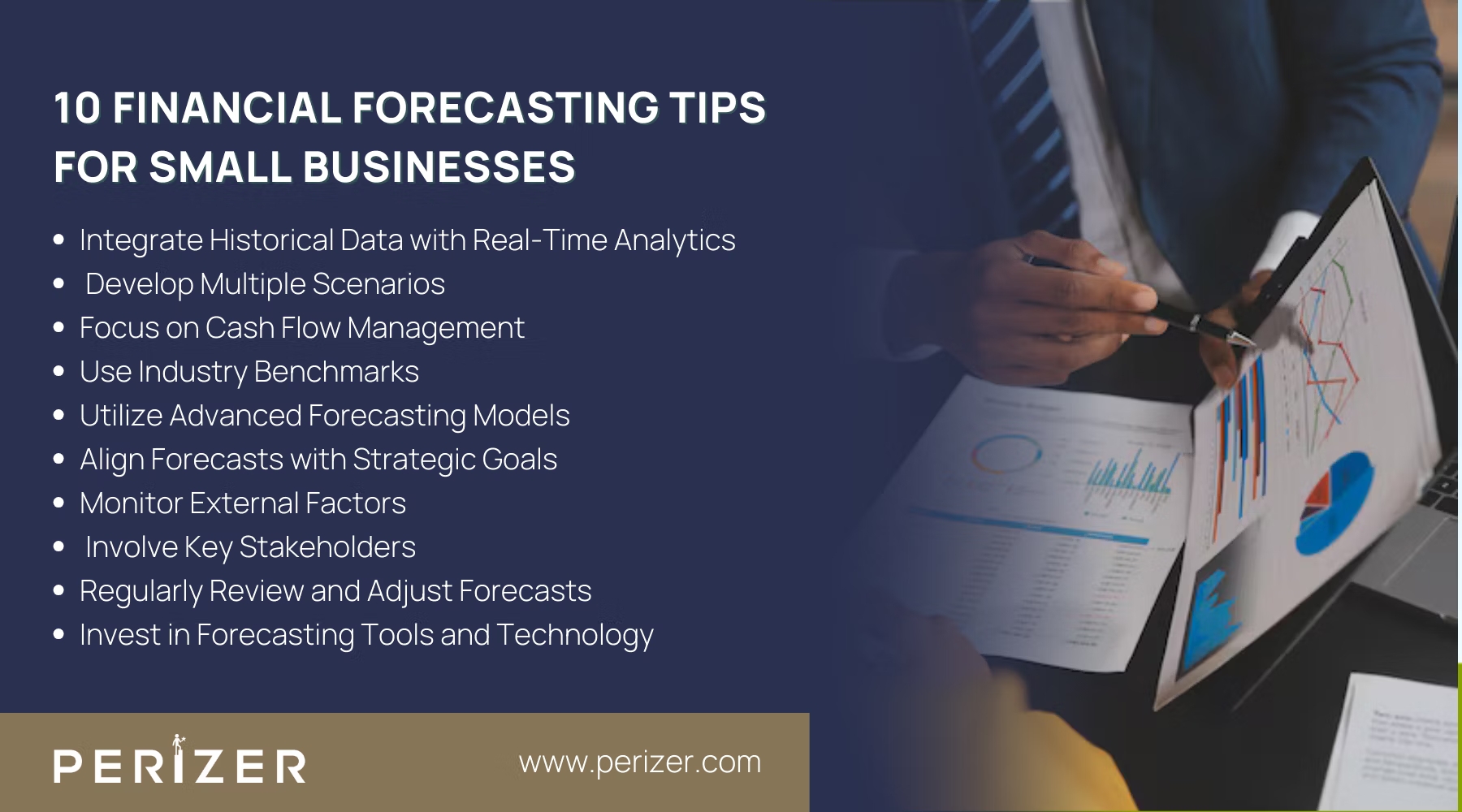Top 10 Financial Forecasting Tips for Small Businesses
Master financial forecasting with our top 10 tips for small businesses. Learn advanced strategies to anticipate challenges, optimize cash flow, and drive growth

Financial forecasting equips you with the ability to identify potential financial gaps before they become critical issues. It allows you to adjust your strategies proactively. Whether you're planning to expand, invest in new technologies, or simply manage day-to-day operations more effectively, a well-crafted financial forecast serves as your roadmap. It provides clarity on where your business is heading and how to allocate resources efficiently to achieve your goals.
Moreover, accurate forecasting builds credibility with investors and stakeholders. It showcases your commitment to informed decision-making and sustainable growth. It also enables you to set realistic financial goals, monitor performance, and measure progress over time. By understanding the financial implications of your decisions in advance, you can avoid costly mistakes and capitalize on opportunities that align with your long-term vision.
Let’s explore the top 10 financial forecasting tips that are essential for your business.
10 Financial Forecasting Tips for Small Businesses

1. Integrate Historical Data with Real-Time Analytics
When creating financial forecasts, it's important to integrate historical data with Historical data provides a solid foundation, but relying solely on it can lead to outdated projections. Real-time analytics allow you to adjust your forecasts based on current market conditions, giving you a more accurate and actionable insight into your business's financial future.
Implementing tools that capture live data streams can be a game-changer. These tools allow you to monitor sales trends, customer behavior, and supply chain dynamics in real time, helping you fine-tune your forecasts as new information becomes available.
2. Develop Multiple Scenarios
Financial forecasting is not about predicting one future but preparing for several. Developing multiple scenarios—optimistic, conservative, and most likely—helps you understand the range of possible outcomes and prepare accordingly. For each scenario, identify the key variables that would impact your business, such as changes in market demand, cost fluctuations, or regulatory changes. By doing so, you can create flexible strategies that allow you to adapt quickly in response to unexpected challenges. Scenario planning also enables you to allocate resources more efficiently. This ensures that you are neither over-committing nor under-preparing.
3. Focus on Cash Flow Management
Cash flow is the lifeblood of any small business. While profit margins are important, without proper cash flow management, even a profitable business can struggle. Forecasting your cash flow involves more than just projecting income and expenses. You must consider the timing of cash inflows and outflows, and understand the impact of delayed payments or unexpected expenses. Implementing a rolling cash flow forecast, updated weekly or monthly, can provide you with a more dynamic view of your liquidity. This approach ensures that you always have a clear picture of your cash position. It allows you to take corrective action before any issues escalate.
4. Use Industry Benchmarks
Comparing your business’s financial performance against industry benchmarks is an effective way to identify areas of improvement and potential risks. However, it's not enough to just know the benchmarks—you need to understand how your business measures up in real-time. Use these benchmarks to refine your forecasts by adjusting for your specific circumstances, such as your market position, geographic location, and customer base. If your business is consistently outperforming or underperforming compared to industry standards, dig deeper to understand why. This analysis will help you make more informed adjustments to your forecasts, ensuring they are as realistic as possible.
5. Utilize Advanced Forecasting Models
As your business grows, so should the sophistication of your forecasting models. Basic models like linear projections might suffice in the early stages, but they can quickly become inadequate as your business evolves. Consider incorporating more advanced forecasting methods, such as regression analysis, time series analysis, or machine learning algorithms. These models can account for complex variables and provide more accurate predictions. For instance, regression analysis can help you identify the relationship between different factors, such as marketing spend and sales growth. This allows you to make more strategic decisions.
6. Align Forecasts with Strategic Goals
Your financial forecasts should be directly aligned with your strategic business goals. Whether you aim to expand into new markets, launch a new product line, or increase your market share, your forecasts should reflect the financial implications of these goals. This alignment ensures that you are not just projecting numbers but are also considering the strategic steps needed to achieve them. Regularly review and adjust your forecasts as your business goals evolve, ensuring that your financial planning remains in sync with your overall strategy. This approach not only keeps your business on track but also helps you secure the necessary resources to achieve your objectives.
7. Monitor External Factors
No business operates in a vacuum, and external factors can significantly impact your financial forecasts. Economic conditions, industry trends, regulatory changes, and even geopolitical events can all influence your business's financial health. It's essential to monitor these external factors continuously and incorporate them into your forecasting process.
For example, if you operate in an industry vulnerable to regulatory changes, stay informed about potential new regulations and assess their financial impact on your business. By doing so, you can proactively adjust your forecasts and develop strategies to reduce any negative effects.
8. Involve Key Stakeholders
Financial forecasting should not be an isolated activity. Involving key stakeholders, such as department heads, financial advisors, and even key customers, can provide valuable insights and ensure that your forecasts are comprehensive. Each stakeholder brings a unique perspective, helping you identify potential risks and opportunities that you might have overlooked. Regularly engage these stakeholders in the forecasting process, using their input to refine your models and assumptions. This collaborative approach not only improves the accuracy of your forecasts but also builds a sense of ownership and commitment to achieving the projected outcomes.
9. Regularly Review and Adjust Forecasts
The business environment is constantly changing, and your financial forecasts should reflect that. Regularly reviewing and adjusting your forecasts is important to staying on track. Set a schedule for revisiting your forecasts, whether it's monthly, quarterly, or after significant business events. During these reviews, compare your actual performance against your forecasts and analyze any variances. Understanding the reasons behind these variances can help you refine your forecasting process, making your future projections more accurate.
Additionally, regular reviews allow you to respond swiftly to any emerging challenges or opportunities, ensuring that your business remains agile and resilient.
10. Invest in Forecasting Tools and Technology
In today's digital age, relying on spreadsheets alone for financial forecasting can be limiting. Investing in specialized forecasting tools and technology can improve the accuracy and efficiency of your forecasts. These tools often come with features like real-time data integration, scenario planning, and advanced analytics, making it easier to create and update forecasts.
Moreover, many of these tools are cloud-based, allowing for collaboration across different departments and locations. By using the latest technology, you can streamline your forecasting process, reduce errors, and gain deeper insights into your business's financial future.
Why is Financial Forecasting Important?
Financial forecasting is not just a financial exercise; it's an important component of strategic business planning. For small businesses, where resources are often limited, accurate forecasting can mean the difference between thriving and merely surviving. It provides the foresight needed to navigate uncertainties, allocate resources effectively, and make informed decisions that align with your business goals.
Without accurate forecasts, you risk making decisions based on incomplete or outdated information, which can lead to cash flow issues, missed opportunities, and even business failure. In essence, financial forecasting is your roadmap to sustained growth and profitability, helping you predict challenges and seize opportunities before they arise.
Conclusion
Mastering financial forecasting is an ongoing process that requires a combination of data analysis, strategic thinking, and technological integration. By applying these advanced tips, you'll be better equipped to predict your business's financial future, make informed decisions, and navigate the complexities of running a small business.
Remember, forecasting is not just about predicting the future—it's about shaping it. By continuously refining your approach and staying adaptable, you can ensure that your business remains resilient, profitable, and poised for growth in any market condition.
FOCUSED, FAST, GOVERNMENT READY
Stay Tuned With Our Latest Insights

Staff Augmentation
Learn how to select the perfect IT outsourcing partner to promote your team’s capabilities, improve productivity, and drRead more...

Staff Augmentation
Find the perfect staff augmentation partner by aligning your goals, evaluating expertise, managing costs, and ensuring aRead more...

Cyber Security
We focus on understanding the needs, behaviors, and expectations of your users through extensive user research. This infRead more...